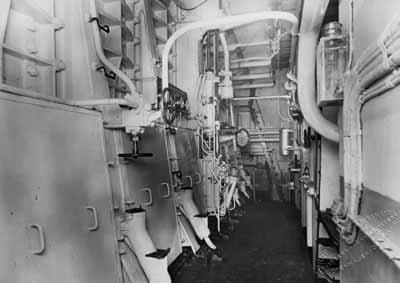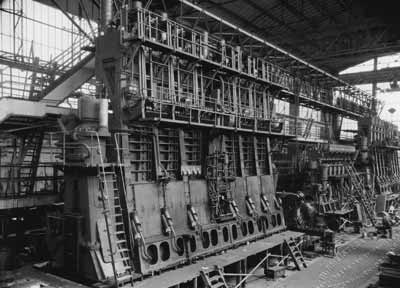| Site Map | Search Warsailors.com | |
|
M/S Siljestad To Siljestad on the "Ships starting with S" page.
Source for all pictures: Historical Department, MAN B&W Diesel, Copenhagen. (Size and quality have been reduced to save space and to reduce download time of this page). Another picture is available on this external page (click in it to enlarge). Captain: Nils Kaltenborn Her voyages are listed on these original images from the Norwegian National Archives: Please compare the above voyages with Arnold Hague's Voyage Record below.
(Received from Don Kindell - His source: The late Arnold Hague's database). Follow the convoy links provided for more information on each.
Judging from the information found on Page 1 of the archive documents, Siljestad was in Alexandria when war broke out in Norway on Apr. 9-1940. Her 1941 voyages also start on this document; it'll be noticed that she appears to have spent quite a long time in Boston that summer, before proceeding to Halifax, and Tony Cooper, a visitor to my website has told me that she joined Convoy HX 142* on Aug. 1 (station 76), together with the Norwegian Nyholt (56), Kristianiafjord (86) and Morgenen (124). The Norwegian Corvus was also initially in this convoy but was sent to SC 39* because she was too slow for HX 142. According to Tony's information 63 ships sailed from Halifax in this convoy, 8 from Sydney, C.B. Kirkpool and Scottish Musician had engine defects and were sent back to Halifax. Like Corvus, the Dutch Hercules was also sent to join SC 39 because of her slow speed. Rotterdam, Murena, Hjelmaren and Narragansett went missing in the fog (from HX 142). Empire Sailor did not join HX 142 till Aug. 6. Perth was the rescue ship. The Commodore says: The following month, Siljestad joined the westbound North Atlantic Convoy ON 12, which left Liverpool on Sept. 1 and dispersed on the 14th. Her destination is not given, but from Page 2 of the archive documents, we learn that she arrived Philadelphia on Sept. 23, proceeding to Hampton Roads that same day. From there, she later sailed to Sydney, C.B. in order to join Convoy SC 49* back to the U.K. on Oct. 11. The convoy arrived Liverpool on Oct. 27, but Siljestad, cargo of steel and tobacco, stopped at Loch Ewe on the 26th, continuing to Methil Roads and Middlesbrough the next day. In Dec.-1941, she's listed in station 84 of Convoy OS 13, together with the Norwegian Finnanger, K. G. Meldahl and Velox (L.A. Christensen was scheduled, but did not sail). Siljestad was on a voyage from Oban to Freetown with general and war stores, having departed Oban on Dec. 1. The convoy originated in Liverpool on Nov. 30 and arrived Freetown on Dec. 20. In Febr.-1942 we find her going in the other direction with Convoy SL 100, which left Freetown for the U.K. on Febr. 9. Her cargo is given as W. A. produce, station 73. K. G. Meldahl was again in company; follow the links provided within the Voyage Record for more info on these 2 convoys. Siljestad arrived Liverpool on March 6, remaining there for almost a month. She left the U.K. again in the westbound North Atlantic Convoy ON 83*, which departed Liverpool on Apr. 4 and arrived Halifax on the 17th. Siljestad, however, was bound for New York, where she arrived on Apr. 20 (again, see Page 2).
With a general cargo and war materials, Siljestad departed New York again for Alexandria (via Cape Town) on May 6-1942. At 21:30 on May 14*, when about 420 n. miles northeast of Barbados she was struck on the port side below the bridge by a torpedo from U-156 (Hartenstein), blowing a large hole in her side, wrecking the bridge and the radio shack. At the time of attack she was on a course 161° true (not zig-zagging), sailing at a speed of 10 1/2 knots in calm seas and good visibility, wind east/southeast force 2-3, no other ships in sight - no distress signal was sent. She was armed and the gun crew were on watch aft, but no counter offensive was offered. 3rd Mate Bjerkseth was on watch on the bridge at the time, with Able Seaman Haugland at the wheel, while Able Seaman Svellingen was on lookout in the starboard pillbox. The 1st and 2nd mates were asleep in their cabins; both managed to get out through the rubble, the 2nd mate through the wall to the adjacent cabin. The captain, who was in his office, was hit by furniture and wall panels, injuring both his legs as well as his hand. His door was blocked, but he was eventually able to get out through a porthole. As he came out on the lower bridge the forward starboard boat was about to be launched, the last to leave the ship, and he and the 2nd mate joined the other 16 in it. The forward port lifeboat had been split in 2 in the explosion. Able Seaman Ellefsen and Ordinary Seaman Johansen jumped overboard from the stern section of the ship after having thrown a small raft out, but the latter did not make it to the raft. The 1st mate and others lowered the aft starboard boat, while the 3rd mate and some others launched the aft port motorboat. However, the motorboat was found to be damaged, so those who were in it were transferred to the 1st mate's boat, holding 13 in all. The motorboat's occupants had seen Ordinary Seaman Schüller lowering himself down the side of the ship, but he did not jump when encouraged to do so, as the motorboat was immediately filled with water. About half an hour after the torpedo had struck, the ship went straight down by the bow. At this time the U-boat surfaced to ask the usual questions about ship and cargo etc., and after having given them the course and distance to Barbados it disappeared again. The survivors proceeded to transfer supplies from the rafts and the damaged motorboat, whereupon the 2 boats headed for land. They were picked up the next morning* (May 15) by the Yugoslavian D/S Kupa which kept both lifeboats hoisted up to her starboard side, while taking care of the survivors and supplementing their lifeboat contents. The intention was to continue in the boats later on, as Kupa was bound for Cape Town, but while the Norwegians were still on board this ship was also torpedoed and sunk by U-156 (port side in No. 1 hatch). She sank by the bow in about 20 minutes - Siljestad's crew were able to get back in their own lifeboats and continued towards Barbados, with 20 in the captain's boat, 11 in the 1st mate's. Kupa's crew members were in 2 lifeboats. The captain's boat lost contact with the others in the course of the night, but on May 18 they spotted a ship with all her lights on (rather an unusual sight for that time). This turned out to be the Las Palmas bound Italian M/T Arcola, which with her clear nationality markings on her side could sail without danger from the German U-boats. Here's something I don't quite understand, the ship is said to have had a British "control crew" on board (why? enlighten me, please!). 3 young British seamen from Siljestad were transferred to the Arcola, while Captain Kaltenborn and 16 others preferred to continue to Barbados, after having been given plenty of food and water. They reached Bridgeport, Barbados in the afternoon of May 20. The 11 men in the 1st mate's boat landed at Guiria on May 23, having been towed in by a patrol boat from the Venezuelan Coast Guard. They were later taken to Trinidad on May 28. The survivors from Kupa reached Barbados, after having sailed for 10 days. The maritime inquiry into Siljestad's loss was held in New York on July 7-1942 with the captain, the 3rd mate, and Able Seamen Haugland and Svellingen appearing.
Crew List:
Related external links: U-156 | Werner Hartenstein - Uboat.net also has an account on the attack on Kupa, as well as a page about Siljestad. Note that the latter states that Siljestad had been spotted at 17:20 the day before, and had been missed with the first two torpedoes at 20:45 and 01:55 (all times here are German time). Back to Siljestad on the "Ships starting with S" page. The text on this page was compiled with the help of: "Nortraships flåte", J. R. Hegland, "Sjøforklaringer fra 2. verdenskrig", Norwegian Maritime Museum, Volume II and misc. (ref. My sources). Summary of statements by survivors (in a memorandum dated June 19 and signed by U.S.N.R. Ensign A. J. Powers) was received from Tony Cooper, England.
|
|||||||||||||||||||||||||||||||||||||||||||||||||||||||||||||||||||||||||||||||||||||||||||||||||||||||||||||||||||||||||||||||||||||||||||||||||||||||||||||||||||||||||||||||||||||||||||||||||||||||||||||||||||||||||||||||||||||||||||||||||||||||||||||||||||||||||||||||||||||||||||||||||||||||||||||||||||||||||||||||||||||||||||||||||||||||||||||||||||||||||||||||||||||||||||||||||||||||||||||||||||||||||||||||||||||||||||||||||||||||||||||||||||||||||||||||||||||||||




